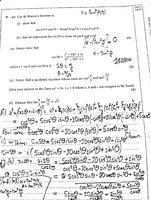You are using an out of date browser. It may not display this or other websites correctly.
You should upgrade or use an alternative browser.
You should upgrade or use an alternative browser.
Quadratic Equation Edexcel F2 June 2017
- Thread starter fasih178
- Start date
- Joined
- Nov 24, 2012
- Messages
- 3,021
I would begin as you did with:
[MATH](\cos(\theta)+i\sin(\theta))^5=\cos(5\theta)+i\sin(5\theta)[/MATH]
[MATH](\cos(\theta)+i\sin(\theta))^5=\cos^5(\theta)+5\cos^4(\theta)i\sin(\theta)+10\cos^3i^2\sin^2(\theta)+10\cos^2(\theta)i^3\sin^3(\theta)+5\cos(\theta)i^4\sin^4(\theta)+i^5\sin^5(\theta)[/MATH]
Hence:
[MATH]\cos(5\theta)+i\sin(5\theta)=(\cos^5(\theta)-10\cos^3\sin^2(\theta)+5\cos(\theta)\sin^4(\theta))+i(5\cos^4(\theta)\sin(\theta)-10\cos^2(\theta)\sin^3(\theta)+\sin^5(\theta))[/MATH]
Equating real and imaginary parts, we find:
[MATH]\cos(5\theta)=\cos^5(\theta)-10\cos^3\sin^2(\theta)+5\cos(\theta)\sin^4(\theta)[/MATH]
[MATH]\sin(5\theta)=5\cos^4(\theta)\sin(\theta)-10\cos^2(\theta)\sin^3(\theta)+\sin^5(\theta)[/MATH]
And so we may write:
[MATH]\tan(5\theta)=\frac{\sin(5\theta)}{\cos(5\theta)}\cdot\frac{\sec^5(\theta)}{\sec^5(\theta)}=\frac{t^5-10t^3+5t}{5t^4-10t^2+1}[/MATH]
Where [MATH]t=\tan(\theta)[/MATH] and \(\cos(\theta)\ne0\)
Now, we know:
[MATH]\tan(\pi)=\tan(2\pi)=0[/MATH]
And so we must have (using the numerator of the above expression for \(\tan(5\theta)\)):
1.) [MATH]\tan^4\left(\frac{\pi}{5}\right)-10\tan^2\left(\frac{\pi}{5}\right)+5=0[/MATH]
2.) [MATH]\tan^4\left(\frac{2\pi}{5}\right)-10\tan^2\left(\frac{2\pi}{5}\right)+5=0[/MATH]
Can you now see the quadratic having the required roots?
[MATH](\cos(\theta)+i\sin(\theta))^5=\cos(5\theta)+i\sin(5\theta)[/MATH]
[MATH](\cos(\theta)+i\sin(\theta))^5=\cos^5(\theta)+5\cos^4(\theta)i\sin(\theta)+10\cos^3i^2\sin^2(\theta)+10\cos^2(\theta)i^3\sin^3(\theta)+5\cos(\theta)i^4\sin^4(\theta)+i^5\sin^5(\theta)[/MATH]
Hence:
[MATH]\cos(5\theta)+i\sin(5\theta)=(\cos^5(\theta)-10\cos^3\sin^2(\theta)+5\cos(\theta)\sin^4(\theta))+i(5\cos^4(\theta)\sin(\theta)-10\cos^2(\theta)\sin^3(\theta)+\sin^5(\theta))[/MATH]
Equating real and imaginary parts, we find:
[MATH]\cos(5\theta)=\cos^5(\theta)-10\cos^3\sin^2(\theta)+5\cos(\theta)\sin^4(\theta)[/MATH]
[MATH]\sin(5\theta)=5\cos^4(\theta)\sin(\theta)-10\cos^2(\theta)\sin^3(\theta)+\sin^5(\theta)[/MATH]
And so we may write:
[MATH]\tan(5\theta)=\frac{\sin(5\theta)}{\cos(5\theta)}\cdot\frac{\sec^5(\theta)}{\sec^5(\theta)}=\frac{t^5-10t^3+5t}{5t^4-10t^2+1}[/MATH]
Where [MATH]t=\tan(\theta)[/MATH] and \(\cos(\theta)\ne0\)
Now, we know:
[MATH]\tan(\pi)=\tan(2\pi)=0[/MATH]
And so we must have (using the numerator of the above expression for \(\tan(5\theta)\)):
1.) [MATH]\tan^4\left(\frac{\pi}{5}\right)-10\tan^2\left(\frac{\pi}{5}\right)+5=0[/MATH]
2.) [MATH]\tan^4\left(\frac{2\pi}{5}\right)-10\tan^2\left(\frac{2\pi}{5}\right)+5=0[/MATH]
Can you now see the quadratic having the required roots?
Thank you! I understood one crucial thing: we need to substitute in pie into LHS tan(5theta) so that we get theta=pie/5, which is one of our roots. And, since tan(pie) = 0, we can set our RHS expression = 0 too. By the same intuition, tan(2pie) is zero. Thus, overall, I understood the idea behind setting tan(5theta) = 0.
But what I don't get is why did you even think about tan(pie) = 0 in the first place -- then going on to using this to solve the problem. That is, you could have instead chosen, say, tan(pie/4) = 1, but you didn't. Why not? What gave you the idea to use tan(pie) = 0?
But what I don't get is why did you even think about tan(pie) = 0 in the first place -- then going on to using this to solve the problem. That is, you could have instead chosen, say, tan(pie/4) = 1, but you didn't. Why not? What gave you the idea to use tan(pie) = 0?
- Joined
- Nov 24, 2012
- Messages
- 3,021
Thank you! I understood one crucial thing: we need to substitute in pie into LHS tan(5theta) so that we get theta=pie/5, which is one of our roots. And, since tan(pie) = 0, we can set our RHS expression = 0 too. By the same intuition, tan(2pie) is zero. Thus, overall, I understood the idea behind setting tan(5theta) = 0.
But what I don't get is why did you even think about tan(pie) = 0 in the first place -- then going on to using this to solve the problem. That is, you could have instead chosen, say, tan(pie/4) = 1, but you didn't. Why not? What gave you the idea to use tan(pie) = 0?
We previously derived the formula:
[MATH]\tan(5\theta)=\frac{t^5-10t^3+5t}{5t^4-10t^2+1}[/MATH]
This gives us a way to relate \(\tan(5\theta)\) to \(\tan(\theta)\). Now consider that:
[MATH]\pi=5\cdot\frac{\pi}{5}[/MATH]
[MATH]2\pi=5\cdot\frac{2\pi}{5}[/MATH]
And so if \(\theta=n\dfrac{\pi}{5}\) then \(5\theta=n\pi\).
The reason I chose values for which \(\tan(5\theta)=0\) is because we are searching for roots of a quadratic. Using the formula relating \(\tan(5\theta)\) to \(\tan(\theta)\), we see that in order for \(\tan(5\theta)=0\) we must have:
[MATH]\tan^5(\theta)-10\tan^3(\theta)+5\tan(\theta)=0[/MATH]
[MATH]\tan(\theta)\left(\tan^4(\theta)-10\tan^2(\theta)+5\right)=0[/MATH]
Now, when we have:
[MATH]0<\theta<\pi[/MATH]
We know \(\tan(\theta)\ne0\), and since both angles under consideration fall within that range, we may divide by \(\tan(\theta)\) to obtain the quadratic in \(\tan^2(\theta)\):
[MATH]\tan^4(\theta)-10\tan^2(\theta)+5=0[/MATH]
Since \(\tan(k\pi)=0\) where \(k\in\mathbb{Z}\), we know the above quadratic is true for all:
[MATH]\theta=k\frac{\pi}{5}[/MATH]
Because of the fact that on the unit circle, an angle of \(\theta\) is equivalent to \(\theta+2k\pi\), we know then that for:
[MATH]\theta\in\left\{k\frac{\pi}{5},(k+1)\frac{\pi}{5}\right\}[/MATH]
[MATH]\tan^2(\theta)[/MATH] must be distinct roots of the quadratic:
[MATH]x^2-10x+5=0[/MATH]
Now given that the product of the two roots of a quadratic is the quotient of the constant term divided by the coefficient of the squared term, we may conclude that:
[MATH]\tan^2\left(k\frac{\pi}{5}\right)\tan^2\left((k+1)\frac{\pi}{5}\right)=5[/MATH]
Since for \(k=1\) we have \(\theta\) in the first quadrant, we can therefore state:
[MATH]\tan\left(\frac{\pi}{5}\right)\tan\left(\frac{2\pi}{5}\right)=\sqrt{5}[/MATH]
Does this make sense?
Oh yes, it does! It makes perfect sense now. However, are there any resources or videos I can watch to hone in on such questions, particularly those that pertain to making these connections using trigonometric functions? I know this was rather intuitive for you, but I have difficulty grasping such connections.

